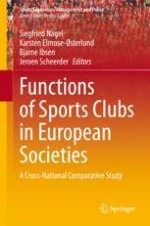2020 | OriginalPaper | Chapter
7. Hungary: Potentials for Civil Initiatives in Sports
Author : Szilvia Perényi
Published in: Functions of Sports Clubs in European Societies
Publisher: Springer International Publishing
Activate our intelligent search to find suitable subject content or patents.
Select sections of text to find matching patents with Artificial Intelligence. powered by
Select sections of text to find additional relevant content using AI-assisted search. powered by
